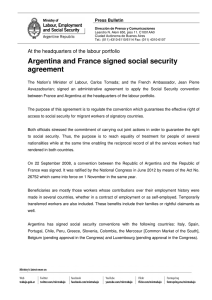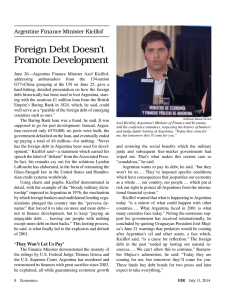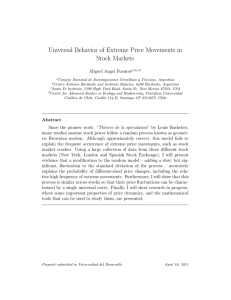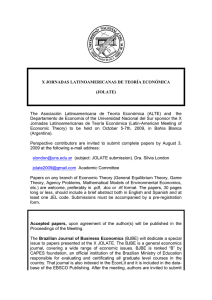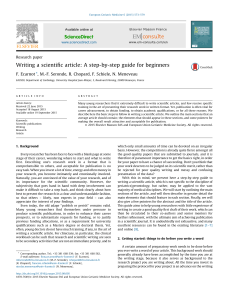Asociación Argentina de Microbiología
Anuncio
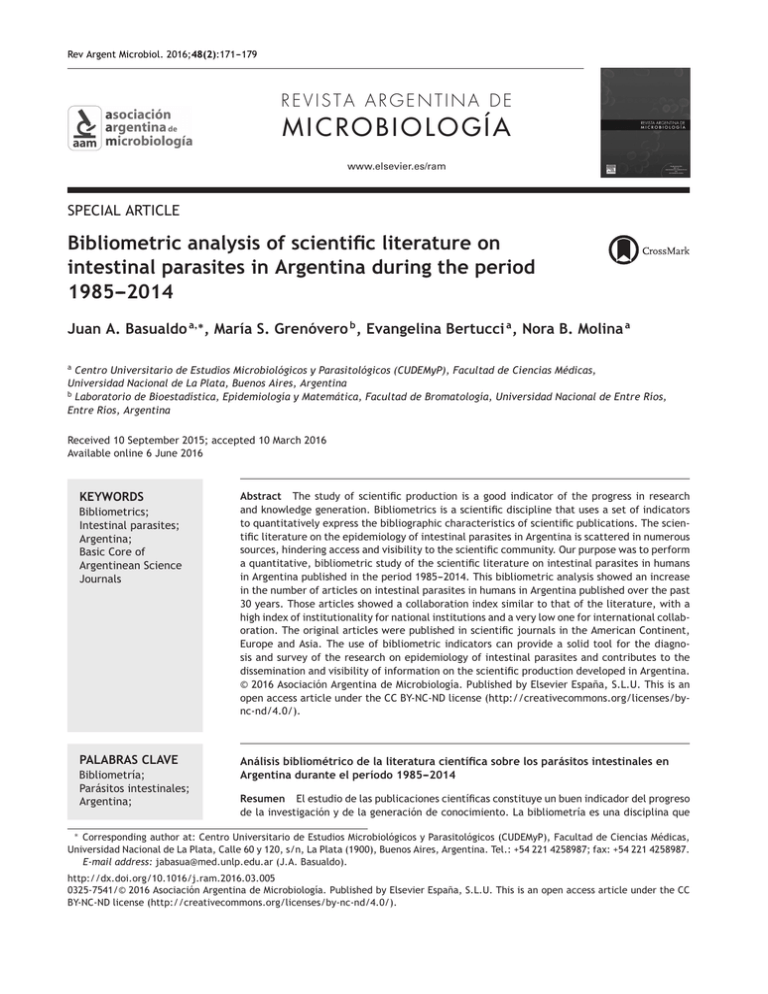
Rev Argent Microbiol. 2016;48(2):171---179 REVISTA ARGENTINA DE MICROBIOLOGÍA www.elsevier.es/ram SPECIAL ARTICLE Bibliometric analysis of scientific literature on intestinal parasites in Argentina during the period 1985---2014 Juan A. Basualdo a,∗ , María S. Grenóvero b , Evangelina Bertucci a , Nora B. Molina a a Centro Universitario de Estudios Microbiológicos y Parasitológicos (CUDEMyP), Facultad de Ciencias Médicas, Universidad Nacional de La Plata, Buenos Aires, Argentina b Laboratorio de Bioestadística, Epidemiología y Matemática, Facultad de Bromatología, Universidad Nacional de Entre Ríos, Entre Ríos, Argentina Received 10 September 2015; accepted 10 March 2016 Available online 6 June 2016 KEYWORDS Bibliometrics; Intestinal parasites; Argentina; Basic Core of Argentinean Science Journals PALABRAS CLAVE Bibliometría; Parásitos intestinales; Argentina; Abstract The study of scientific production is a good indicator of the progress in research and knowledge generation. Bibliometrics is a scientific discipline that uses a set of indicators to quantitatively express the bibliographic characteristics of scientific publications. The scientific literature on the epidemiology of intestinal parasites in Argentina is scattered in numerous sources, hindering access and visibility to the scientific community. Our purpose was to perform a quantitative, bibliometric study of the scientific literature on intestinal parasites in humans in Argentina published in the period 1985---2014. This bibliometric analysis showed an increase in the number of articles on intestinal parasites in humans in Argentina published over the past 30 years. Those articles showed a collaboration index similar to that of the literature, with a high index of institutionality for national institutions and a very low one for international collaboration. The original articles were published in scientific journals in the American Continent, Europe and Asia. The use of bibliometric indicators can provide a solid tool for the diagnosis and survey of the research on epidemiology of intestinal parasites and contributes to the dissemination and visibility of information on the scientific production developed in Argentina. © 2016 Asociación Argentina de Microbiologı́a. Published by Elsevier España, S.L.U. This is an open access article under the CC BY-NC-ND license (http://creativecommons.org/licenses/bync-nd/4.0/). Análisis bibliométrico de la literatura científica sobre los parásitos intestinales en Argentina durante el período 1985---2014 Resumen El estudio de las publicaciones científicas constituye un buen indicador del progreso de la investigación y de la generación de conocimiento. La bibliometría es una disciplina que ∗ Corresponding author at: Centro Universitario de Estudios Microbiológicos y Parasitológicos (CUDEMyP), Facultad de Ciencias Médicas, Universidad Nacional de La Plata, Calle 60 y 120, s/n, La Plata (1900), Buenos Aires, Argentina. Tel.: +54 221 4258987; fax: +54 221 4258987. E-mail address: [email protected] (J.A. Basualdo). http://dx.doi.org/10.1016/j.ram.2016.03.005 0325-7541/© 2016 Asociación Argentina de Microbiologı́a. Published by Elsevier España, S.L.U. This is an open access article under the CC BY-NC-ND license (http://creativecommons.org/licenses/by-nc-nd/4.0/). 172 Núcleo Básico de Revistas Científicas Argentinas J.A. Basualdo et al. utiliza un conjunto de indicadores para expresar cuantitativamente las características bibliográficas de las publicaciones. La literatura científica sobre la epidemiología de los parásitos intestinales en la Argentina se encuentra muy dispersa en numerosas fuentes impresas y online, con escasa visibilidad para la comunidad científica. Nuestro objetivo fue realizar un estudio bibliométrico cuantitativo de la literatura científica publicada sobre los parásitos intestinales de humanos en Argentina durante el período 1985---2014. Este análisis mostró un incremento en el número de documentos publicados en los últimos 30 años. Dicha publicaciones mostraron un índice de colaboración similar a la literatura, con un alto índice de institucionalidad para las instituciones nacionales y un índice bajo para la colaboración internacional. Los artículos fueron publicados en revistas científicas del continente americano, Europa y Asia. El uso de indicadores bibliométricos proporciona una herramienta sólida para el diagnóstico y estudio de la investigación sobre la epidemiología de los parásitos intestinales y contribuye a la difusión y visibilidad de la información sobre la producción científica desarrollada en Argentina. © 2016 Asociación Argentina de Microbiologı́a. Publicado por Elsevier España, S.L.U. Este es un artı́culo Open Access bajo la CC BY-NC-ND licencia (http://creativecommons.org/licencias/bync-nd/4.0/). Introduction The development of science as a system is governed by the production and flow of information until it becomes knowledge. Science journals are traditionally the primary means of communication and preservation of scientific advances through the publication of scientific articles21,75 . Bibliometric indicators are numerical data estimated from the bibliographic characteristics seen in published documents, allowing the analysis of various features of scientific activity, linked both to output and consumption of information7,11,21,32,43,89,92 . Bibliometric laws include several laws for the regulation of matters regarding the distribution of articles in scientific journals, the authors of publications, the exponential growth of scientific knowledge, the obsolescence of the publications and the dispersion of scientific literature7,21,75,87 . The growth of scientific information occurs at a markedly higher rate than other social phenomena. This growth has four stages: precursors, exponential growth phase, linear growth phase and collapse or saturation of information in a subject area. While there are variations in the different areas of knowledge, information is growing exponentially and its growth can be expressed as: N = N0 × ebxt , where N is the measured variable related to the size of science; N0 is the measured variable at time t = 0; t is time, and b is a constant relating the growth rate7,21,75 . Obsolescence of knowledge is a function of time and can be measured by several indicators. The index of obsolescence represents the relationship between recent references and total references, conveying a sense of obsolescence of the literature and can be expressed as IO = number of recent citations/number of total citations × 1007,21,75,92 . The dispersion of scientific literature allows to organize the journals by decreasing productivity. This law reveals that most of the documents specialized in a subject area are concentrated on a few journals and are represented by the following formula: Jp = C × p − 2, where Jp is the number of scientific journals, p is the number of publications and C is a constant7,21 . Collaboration in science can be conceptualized as the research effort by research groups that interact in a supplementary and specialized form. This collaboration is a growing phenomenon in most areas of research that can share resources and promote the development of scientific networks to enrich the intellectual and social skills of the researchers. This index is calculated by the weighted average number of authors per paper divided by the number of papers presented at an institution or journal20,75,78 . Infections by intestinal parasites are a world publichealth issue due to their high prevalence, wide geographic distribution and effects on the nutritional status and immunity of the population61 . Intestinal parasites add to the burden caused by communicable diseases and cause economic losses all over the world, primarily in developing countries. They affect a third of the world population with varying prevalence in different regions. The higher parasitic infections rates are observed in Latin America, China, South East Asia, and Sub-Saharan Africa11,12,15 . Developed countries record approximately 88% of all scientific and technical literature included in the Journal Citation Report, while Latin America contributes with less than 5% of the total published53 . In recent years, Latin America and Asia have increased their scientific productivity in the area of parasitology. In Argentina, scientific research on intestinal parasites has been conducted in humans in spatially limited areas, showing heterogeneity in geographic and population distribution and being subject to a variety of socio-economic, environmental and climatic influences. Scientific publications are scattered among numerous sources of information, both electronic and printed, making their access and visibility to the scientific community harder. Therefore, the volume, evolution, visibility and structure of scientific research in human parasitology are yet to be determined. Our purpose was to perform a quantitative, bibliometric study of the scientific literature published on intestinal parasites in Argentina in the period 1985---2014. Number and typology of documents Analyzing scientific publications is an essential component in the research process. It has become a useful tool to rate the Bibliometrics of intestinal parasites in Argentina quality of the knowledge-generating process and its impact on the academic world21,43,75,92 . The number and type of published documents is the simplest indicator to study scientific literature. We found 177 documents associated with human infection of intestinal parasites in Argentina published in the past 30 years. The scientific publications were categorized as follows: periodical (articles in journals), non-periodical (dissertations and books), and limited circulation (Conference Proceedings or communications). According to documentary typology, we found 46 original articles, 128 communications to scientific meetings, two graduate dissertations, and one book chapter. Chronological evolution of documents A basic phenomenon of the production of scientific knowledge is its exponential growth21,75 . We found 13 publications in the first decade (1985---1994), 81 publications in the second decade (1995---2004), and 83 publications in the third decade (2005---2014). The two dissertations and the book chapter were included in the last period. The global evolution of publications on intestinal parasites in Argentina showed a stationary growth in the last twenty years. However, the chronological analysis according to documentary typology indicated that the number of original articles more than doubled, while communications to meetings showed a numerical decrease in the same period (Fig. 1). A report from the Network on Science and Technology Indicators (RICYT) showed that the amount of articles published by Latin American authors in science journals registered in the Science Citation Index (SCI) doubled in 2002---2011, showing a growth close to 2%70 . A Global Research Report published by Web of Science (WoS) indicates that Brazil, Mexico and Argentina are the Latin American countries having the largest increase in volume of publications over the last 20 years1 . Similar results were provided by the National University of La Plata (UNLP), which reported a large increase in scientific production in journals indexed in the Web Library of Science, Scopus, SciELO and RedALyC85,86 . The growing trend of publications on intestinal parasites is in agreement with the regional increase in scientific output and might 90 N.º of publications 80 70 60 50 40 30 20 10 0 1985-1994 1995-2004 2005-2014 Periods N.º articles N.º comunications N.º of publications Figure 1 Chronological evolution of the number of total publications, original articles and communications published on intestinal parasites in humans in Argentina over three ten-year periods: 1985---1994, 1995---2004, and 2005---2014. 173 be attributed to an increase in parasite prevalence in the country, public health research, institutional collaboration and rate of medical science researchers, significant advance in diagnostic methods, improved infrastructure related to biomedical research, introduction of new journals or more funding from international organizations12,20,23,91,92 . Language Language plays a major role in the readership of scientific and research articles. English is generally considered to be the lingua franca of the scientific community and roughly 80% of all the journals indexed in Scopus are published in this language. Spanish was the language used in 100%, 89%, and 87% of the articles reported in the first, second and third decade, respectively. The remaining articles were written in English and all communications were written in Spanish. Unlike international publication patterns, Spanish was the language of publication of most of the 177 documents. This might be due to the journals chosen for publication of the articles and/or to the geographical scope of scientific meetings (Argentina, Latin America or Spain)46,71,84,86,88,92 . Collaboration between authors and research institutions The participation of several authors in a research is a consequence of the professionalization of the scientific community. Collaboration in science can be conceptualized as the research effort by research groups that interact in a supplementary and specialized form. This collaboration is a growing phenomenon in most areas of research that can share resources and promote the development of scientific networks to enrich the intellectual and social capacities of the researchers. The Collaboration Index (CI: number of signatures per publication) shows distinctive values according to the subject field and ranges from 3 to 5 authors, however, for health-related research, the CI per article reached values of 2.7 and 3 in the WHO/PAHO databases and Medline, respectively21,32,60 . In this review, the Collaboration Index (CI) reached an average of 5 and was similar between original articles and communications. The total number of authors per publication ranged from 1 to 14, except for one scientific communication that showed a high number of signatures68 . The CI values found for this bibliometric study were close to those reported in the literature for parasitological studies12,32,37,42,43,92 . The Index of Institutionality (II: number of scientific institutions per publication) measures the collaboration among authors from different institutions. The research institutions to which the authors belong were available in 89.8% of the papers. For original articles, the II reached 76.4% for collaboration and 18.9% for communications. We found that three out of four original articles were written in collaboration with researchers from two or more Argentinean institutions, showing a high interaction among investigators in the field of human parasitology. Only four of the articles had international collaboration (Spain, Italy, United States and Australia)2,21,36,41,45,75 . 174 J.A. Basualdo et al. Table 1 Distribution of original articles in national and international journals publishing articles on intestinal parasites in humans in Argentina during 1985---2014. Journal Country JCR/SCIEa Acta Bioquímica Clínica Latinoamericanab,c Acta Tropica American Journal of Human Biology Annals of Tropical Medicine & Parasitology Boletín Chileno de Parasitología Bulletin of PAHO Cadernos de Saúde Pública Clinical and Vaccine Immunology European Journal of Epidemiology Higiene y Sanidad Ambiental International Journal of Tropical Medicine International Scholarly Research Network Microbiology Journal of Infection in Developing Countries Journal of The Selva Andina Research Society Medicina (Buenos Aires)b,c Nutrición Clínica y Dietética Hospitalaria Pan American Journal of Public Healthd Parasites & Vectors Parasitología al día Parasitología Latinoamericanad Polibotánica Prensa Médica Argentina Revista Argentina de Antropología Biológicab Revista Argentina de Microbiología Revista Argentina de Parasitología Revista Argentina de Salud Públicab Revista de Saúde Pública Revista do Instituto de Medicina Tropical de Sao Paulo Revista Ibero-Latinoamericana de Parasitología Revista Latinoamericana de Microbiología The Korean Journal of Parasitology World Journal of Gastroenterology Argentina Netherlands United States United Kingdom Chile United States Brazil United States Netherlands Argentina Pakistan United States Italy Bolivia Argentina Spain United States United Kingdom Chile Chile Mexico Argentina Argentina Argentina Argentina Argentina Brazil Brazil Chile Mexico Korea United States Yes8,25,39,40 Yes29 Yes58 Yes51 No67 No6 Yes57 Yes41 Yes26,36 No69 No81 No17 Yes52 No30 Yes44,48 No31,98 Yes4,27,65 Yes2,45 No13 No14,74,83,99 No56 No38 No10,59 Yes93 No97 No73 Yes80 Yes3 No16 No82 Yes49 Yes66 a b c d JCR/SCIE Journal Citation Report and Science Citation Index Expanded. NBR Argentinean journals indexed in the Basic Core of Argentinean Science Journals. Journals of Argentina that concentrate the original articles on epidemiology of intestinal parasites. Journals of America that concentrate the original articles on epidemiology of intestinal parasites. In Latin America, international collaboration in the health area ranges between 25% and 36% and shows a heterogeneous pattern91,92 . Similar rates of collaboration (30---42%) were observed in five public universities in Argentina85 . However, in epidemiology of human parasites, there was minimal collaboration of Argentinean authors with their peers from foreign institutions. The II for communications on intestinal parasites was close to 20%, showing less inter-institutional collaboration for scientific meetings. This institutional collaboration profile matches the findings of another bibliometric study, where an II close to 24% was found in the communications presented in several biochemistry conferences in Argentina43 . Bibliometrics of original articles The global scientific output of public health work is led by North American and Western Europe countries. As from 2005, publications originating in Latin America have thrived widely, reaching about 9% of all documents published. Brazil and Mexico were the two countries contributing with the highest number of publications12,32,33,53,62,77,92 . In Argentina, original articles on intestinal parasites were published in 32 journals in several countries from the American Continent, Europe and Asia (Table 1). The countries with the highest number of publications on this topic were Argentina, United States and Chile. The scattering of scientific information is an issue of great practical significance. Most of the articles are concentrated on a highly reduced core of journals, while the rest of the publications spread over a high number of journals (Bradford’s Law of Scattering) (Table 1). The Web of Science website indexes about 9300 research journals and offers Journal Citation Reports (JCR) and Science Citation Index Expanded (JCR/SCIE) that examine the presence and impact of the journals. The Basic Core of Argentinean Science Journals (NBR) was implemented in 175 70.0 100 60.0 80 50.0 40.0 60 30.0 40 20.0 20 2014 2014 2013 2012 2011 2011 2011 2011 2011 2010 2010 2009 2007 2007 2007 2005 2004 2003 10.0 1999 0 Index of obsolescence 80.0 120 1996 Number of reference/article Bibliometrics of intestinal parasites in Argentina 0 Year of publication Index of price, % N.º references < 5 year Figure 2 Chronological evolution of the number of recent references per article, number of total references per article and Index of Obsolescence (IO) of the original articles published on intestinal parasites in humans in Argentina, over year of publication. The IO of the publication before 1996 could not be access the full text. Bars: Index of Obsolescence, full line: number of total references, dashed line: number of recent references (under 5 years old). Argentina to include periodical science and technology publications in the country subjected to a thorough evaluation using a definite set of quality and significance criteria. We found that 50% of the articles on intestinal parasites in Argentina were published in journals included in the JCR/SCIE and 22% in journals from the NBR. We observed higher numbers than those previously reported for parasitology articles by Latin American authors recorded in journals included in the JCR23 . References in academic writing may be used as the ultimate authority upon which to base arguments. A number of bibliometric studies have quantified the number of references in publications and most of the papers include almost 15 references per article. Several journals written in Spanish had an average of 20 references per article24 . In this review, the number of bibliographic references per article ranged from 4 to 116, showing an increase in time and was higher than what was indicated in other works21,32,46,60,62,72,78,90 . Scientific information loses validity over time. This phenomenon can be measured by several indicators. The Index of Obsolescence (IO) represents the relationship between recent references and total references, conveying a sense of the obsolescence of the literature. In scientific disciplines where current literature is more frequent, this index gets close to 50%24 , decreasing as historical literature increases. Several bibliometric studies on medicine and public health have reported this index with values between 20% and 47%9,24,54,78,90 . In this work, the number of recent references per article, the number of total references per article, and the average IO were 10, 34, and 28.5%, respectively (Fig. 2). The published articles included in this bibliometric study showed an IO within the rates reported by others authors9,24,54,78,90 . Literature search is an important part of any research and publication activity. Electronic databases of medical literature nowadays come with very versatile tools for searching and retrieving information. Abstracts are usually followed by a list of keywords selected by the author. The instructions for authors will state how many keywords are required. Choosing appropriate keywords is important, because these are used for indexing purposes. Well-chosen keywords enable your manuscript to be more easily identified and cited. For clinical papers, keywords may need to be chosen from the Medical Subject Headings list. Only 36 original articles included keywords. The authors employed a total of 121 words as descriptors; however, a minimum core of 64 unrepeated words was observed. The most frequent terms were: Argentina, intestinal parasites, enteroparasitosis, intestinal parasitosis, helminths, protozoa, Giardia, Blastocystis, epidemiology, nutritional status, and children. The names of Argentinean provinces included among the keywords were: Córdoba, Mendoza, Misiones, Entre Ríos, and Salta. Bibliometrics of scientific communications Gray, unconventional or informal literature is any kind of document not disseminated through the ordinary publication channels, which include printed documents of limited production, with contents addressed to specialized readers and generally not adhering to standards of bibliographical control. The 128 scientific communications were presented in 33 scientific meetings, with an average of 4 communications per event. The meetings were divided according to their subject field into: Pediatrics18,22,28,35,64 (Congreso Argentino de Infectología Pediátrica, Congreso Argentino de Pediatría General Ambulatoria, Congreso Nacional de Pediatría, Encuentro Nacional de Investigación Pediátrica); Biochemistry/Microbiology (Congreso Argentino de Bioquímica, Congreso Argentino de Microbiología), Parasitology55,63,76,79,95 (Congreso Argentino de Parasitología, Congreso Argentino de Protozoología, Congreso Latinoamericano de Parasitología, Jornadas Nacionales de Enteroparasitosis), Zoonosis5,19,50,94 (Congreso Argentino de Zoonosis, Congreso Bonaerense de Zoonosis, Congreso Internacional de Zoonosis, Congreso Latinoamericano de Zoonosis), and assorted matters34,96 (Jornadas Nacionales de Antropología Biológica, Reunión de Comunicaciones Científicas y Tecnológicas, Congreso Regional de Ciencia y Tecnología, Congreso Argentino de Redes de Laboratorio, Congreso Latinoamericano de Gastroenterología). All communications were published in Conference Proceedings (85; 66%) and two journals included in the NBR (43; 34%). Proceedings have a restricted circulation while journals provide increased availability and visibility of investigation results, intrinsic phenomena of the scientific activity. Scientific communications on intestinal parasites were presented in numerous scientific meetings, showing a wide scattering of the literature. The CI of communications was similar to that found in original articles, indicating the number of collaborators bore no relation to the documentary typology. However, the II was different in both types of documents revealing that the collaboration between institutions was limited for original articles. We found collaboration between institutions lower than 20% for scientific communications. This situation differs from those published by other authors, who reported a collaborative work in medical topics close to 45%43,47 . Conclusion Quantitative evaluation of publication and citation data is now used in many countries with a sizeable science 176 enterprise. Bibliometrics is used in research performance evaluation, especially in university and government labs, and also by policymakers, research directors, information specialists, librarians and researchers75 . This study showed an increase in the number of articles published on intestinal parasites in humans in Argentina over the last 30 years. Those articles showed a collaboration index similar to that of the literature, with a high index of institutionality for national institutions and a low one for international collaboration. The Index of Obsolescence showed a lower percentage since recent literature has been published on this subject field. The bibliometric analysis of communications showed a high number of works in scientific meetings, a Collaboration Index similar to that of the original articles and a remarkably lower Index of Institutionality. Those papers were mostly published in Conference Proceedings, with limited access and availability. Studying the scientific output in a given subject field continues to be a good marker of research advance and knowledge generation. Both the growth of scientific production in recent decades and its indexation in computerized bibliographic databases have enhanced the use of bibliometrics and the creation of indicators to measure the results of scientific and technological activity. This field of study allows researchers to examine scientific advances in retrospect and to characterize the development, obsolescence and scattering of scientific publications in Argentina. Ethical disclosures Protection of human and animal subjects. The authors declare that no experiments were performed on humans or animals for this study. Confidentiality of data. The authors declare that no patient data appear in this article. Right to privacy and informed consent. The authors declare that no patient data appear in this article. Conflict of interest The authors declare that they have no conflicts of interest. References 1. Adams J, King C. Global Research Report Brazil. Research and Collaboration in the New Geography of Science. Evidence Ltd. Thomson Reuters; 2009, p 5. 2. Barda B, Cajal P, Villagran E, Cimino R, Juarez M, Krolewiecki A, Rinaldi L, Cringoli G, Burioni R, Albonico M. Mini-FLOTAC, KatoKatz and McMaster: three methods, one goal; highlights from north Argentina. Parasit Vectors. 2014;7:271---8. 3. Basualdo JA, Córdoba MA, De Luca MM, Ciarmela ML, Pezzani BC, Grenovero MS, Minvielle MC. Intestinal parasitoses and environmental factors in a rural population of Argentina, 2002---2003. Rev Inst Med Trop S Paulo. 2007;49:251---5. 4. Beltramino D, Lura MC, Carrera E. El tratamiento antihelmíntico selectivo frente al tratamiento masivo. Experiencia en dos comunidades hiperendémicas. Panam J Pub Health. 2003;13:10---8. J.A. Basualdo et al. 5. Bethencourt A, Kozubsky L, Gamboa M, Medina P, Barboza D. Criptosporidiosis en una población infantil: consideraciones epidemiologicas. I Congreso de Zoonosis, 2003, P21, p. 68. La Plata, Argentina. 6. Borda CE, Rea MJF, Rosa JR, Maidana C. Intestinal parasitism in San Cayetano, Corrientes, Argentina. Paho Bull. 1996;30:227---33. 7. Bordons M, Zulueta MA. Evaluación de la actividad científica a través de indicadores bibliométricos. Rev Esp Cardiol. 1999;52:790---800. 8. Bracciaforte R, Díaz MF, Vottero Pivetta V, Burstein V, Varengo H, Orsilles MA. Enteroparásitosis en niños y adolescentes de una comuna periurbana de la provincia de Córdoba. Acta Bioquim Clin Latinoam. 2010;44:353---8. 9. Camps D. Análisis bibliométrico de reportes de casos publicados en los volúmenes 46 y 47 de la revista Patología. Patología. 2010;48:230---3. 10. Cesani MF, Zonta ML, Castro L, Torres MF, Forte LM, Orden AB, Quintero FA, Luis MA, Sicre ML, Navone GT, Gamboa MI, Oyhenart EE. Estado nutricional y parasitosis intestinales en niños residentes en zonas urbana, periurbana y rural del partido de Brandsen (Buenos Aires, Argentina). Rev Arg Antropol Biol. 2007;9:105---21. 11. Chinchilla-Rodríguez Z, Benavent M, Miguel S, Moya-Anegón F. International Collaboration in Medical Research in Latin America and the Caribbean (2003---2007). J Am Soc Inform Sci Technol. 2012;63:2223---8. 12. Chinchilla-Rodríguez Z, Zacca-González G, Vargas B, MoyaAnegón F. Latin American scientific output in Public Health: combined analysis using bibliometric, socioeconomic and health indicators. Scientometrics. 2015;102:609---28. 13. Costamagna S, Torno Cafasso O, Garcia SH, Visciarelli E, Osorio J, Santamaría B. Enteroparásitos en niños residentes en zona rural del partido de Carmen de Patagones provincia de Buenos Aires, Argentina. Parasitol Today. 1999;23:1---2. 14. Costamagna SR, Garcia S, Visciarelli E, Casas N. Epidemiología de los parasitosis en Bahía Blanca (Provincia de Buenos Aires) Argentina-1994/1999. Parasitol Latinoam. 2002;57: 103---10. 15. Crompton DW, Montresor A, Nesheim MC, Savioli L. Controlling disease due to helminth infections. 2003. WHO Library, Cataloguing-in-Publication data. [on-line] http://whqlibdoc. who.int/publications/2003/9241562390.pdf Consulted in 28.03.2015. 16. Diaz Cajal MA, Varengo HT, Marini V, Orsilles MA. Prevalencia de Blastocystis sp. en niños y adolescentes de comunas periurbanas de la ciudad de Córdoba, Argentina. Rev Ibero---Latinoam Parasitol. 2011;70:35---41. 17. Dib J, Oquilla J, Lazarte SG, Gonzalez SN. Parasitic prevalence in a suburban school of Famaillá, Tucumán, Argentina. ISRN. 2012;2012:1---4. 18. Dubcovsky G, Quinzán L, Cavallaro G. Enteroparasitosis en Fuerte Apache. In: III Congreso de Pediatría General Ambulatoria. 2004. RP 006, p. 7. 19. Echenique C, Bogino B, Racca L, Magaró H. Giardia lamblia y otros parásitos intestinales hallados en una comunidad Toba, Rosario, Argentina. In: III Congreso Latinoamericano de Zoonosis. 2008. P 027, p. 32. 20. Escobedo A, Arencibia R, Vega R, Rodriguez-Morales A, Almirall P, Alfonso M. A bibliometric study of international scientific productivity in giardiasis covering the period 1971---2010. J Infect Develop Ctries. 2015;9:76---86. 21. Escorcia TA. El análisis bibliométrico como herramienta para el seguimiento de publicaciones científicas, tesis y trabajos de grado. 2008 Tesis de Posgrado. Universidad Javeriana Pontificia. 22. Espósito N, Rivero R, Barberis C, Chiaretta A. Endoparasitosis infantil en áreas de riesgo de la ciudad de Rio Cuarto. In: XXXIII Congreso Argentino de Pediatria. 2003. RP 564. Bibliometrics of intestinal parasites in Argentina 23. Falagas M, Papastamataki P, Bliziotis I. A bibliometric analysis of research productivity in parasitology by different world regions during a 9-year period (1995---2003). BMC Infect Dis. 2006;6:56---61. 24. Fernández Brizuela E. Estudio bibliométrico sobre lactancia materna en las revistas médicas cubanas durante el período 2009---2013. Rev Cuba Inf Cienc Salud. 2004;25:270---84. 25. Gamboa MI, Navone GT, Kozubsky L, Costas ME, Cardozo M, Magisterio P. Protozoos intestinales en un asentamiento precario: manifestaciones clínicas y ambiente. Acta Bioquim Clin Latinoam. 2009;43:213---8. 26. Gamboa M, Basualdo J, Kozubsky L, Costas E, Cueto Rua E, Líate H. Prevalence of intestinal parasitosis within three population groups in La Plata, Argentina. Eur J Epidemiol. 1998;14: 55---61. 27. Gamboa M, Kozubsky L, Costas M, Garraza M, Cardozo M, Susevich M, Magisterio P, Navone G. Associations between geohelminths and socioenviromental conditions among different human populations in Argentina. Panam J Pub Health. 2009;26:1---8. 28. Gamboa MI, Navone GT, Kozubsky L, Oyhenart E, Costas ME, Torres MF, Cardozo M, Orden B, Zuliani MV. Situación epidemiológica de las parasitosis intestinales y estado nutricional infantil en una población periurbana de la ciudad de La Plata. In: XXXIII Congreso Argentino de Pediatría. 2003. SP548. 29. Gamboa MI, Navone GT, Orden AB, Torres MF, Castro LE, Oyhenart EE. Socio-environmental conditions, intestinal parasitic infections and nutritional status in children from a suburban neighborhood of La Plata, Argentina. Acta Trop. 2011;118:184---9. 30. Gamboa MI, Zonta L, Navone GT. Parásitos intestinales y pobreza: la vulnerabilidad de los más carenciados en la Argentina de un mundo globalizado. J Selva Andina Res Soc. 2010;1:23---37. 31. Garraza M, Zonta ML, Oyhenart EE, Navone GT. Estado nutricional, composición corporal y enteroparasitosis en escolares del departamento de San Rafael, Mendoza, Argentina. Nutr Clín Diet Hosp. 2014;34:31---40. 32. González de Dios J, Moya M, Mateos Hernández MA. Indicadores bibliométricos: características y limitaciones en el análisis de la actividad científica. An Esp Pediatr. 1997;47:235---44. 33. González de Dios J, Paredes Cencillo C. Congresos de la Asociación Española de Pediatría: debate a partir de su análisis bibliométrico. An Pediatr (Barc). 2004;61:520---32. 34. Gonzalez GN, Ñunez MR, Pianciola LA. Prevalencia de Dientamoeba fragilis en un hospital de Neuquén. In: II Congreso Argentino de redes de laboratorio. 2005. P54, p. 27. 35. Guercio L, Tripodi A, Parral H. Estudio comparativo de prevalencia de enteroparasitosis en distintas zonas del área programática del sistema de salud municipal. In: XXXIII Congreso Argentino de Pediatría. 2003. RP 683. 36. Guignard S, Arienti H, Freyre L, Lujan H, Rubinstein HR. Prevalence of enteroparasites in a residence for children in the Cordoba Province, Argentina. Eur J Epidemiol. 2000;16:287---93. 37. Harande YI, Alhaji IU. Basic literature of diabetes: a bibliometrics analysis of three countries in different world regions. J Libr Inform Sci. 2014;2:49---56. 38. Holod S, Del Carmen Campos M, Pengue C, Querejeta M. Prevalence of intestinal parasitisim in patients studied at the laboratory of a hospital from Buenos Aires, to be submitted to parasitologic test. Prensa Med Argent. 2003;90:547---54. 39. Indelman P, Echenique C, Bertorini G, Racca L, Gomez C, Luque A, Magaró HM. Parasitosis intestinales en una población pediátrica de la ciudad de Rosario, Santa Fe, Argentina. Acta Bioquim Clin Latinoam. 2011;45:329---34. 40. Kozubsky L, Archelli S. Algunas consideraciones acerca de Blastocystis sp., un parásito controversial. Acta Bioquím Clín Latinoam. 2010;44:371---6. 177 41. Krolewiecki AJ, Ramanathan R, Fink V, McAuliffe I, Cajal SP, Won K, Juarez M, Di Paolo A, Tapia L, Acosta N, Lee R, Lammie P, Abraham D, Nutman TB. Improved diagnosis of Strongyloides stercoralis using recombinant antigen-based serologies in a community-wide study in Northern Argentina. Clin Vacc Inmunol. 2010:1624---30. 42. Lancho-Barrantes B, Guerrero-Bote V, Moya-Anegón F. Citation increments between collaborating countries. Scientometrics. 2013;94:817---31. 43. Martínez A, Fink N. Análisis Bibliométrico de las comunicaciones presentadas en el Congreso Nacional Bioquímico entre 1997 y 2005. Acta Bioquím Clín Latinoam. 2008;42:261---9. 44. Menghi CI, Iuvaro FR, Dellacasa MA, Gatta CL. Investigación de parásitos intestinales en una comunidad aborigen de la provincia de Salta. Medicina (Buenos Aires). 2007;67:705---8. 45. Mera y Sierra R, Agramunt P, Cuervo P, Mas Coma S. Human fascioliasis in Argentina: retrospective overview, critical análisis and baseline for future research. Parasit Vectors. 2011;4:104---23. 46. Miguel S, Dimitri PJ. La investigación en bibliometría en la Argentina: quiénes son y qué producen los autores argentinos que realizan estudios bibliométricos. Inf Cult Soc. 2013;29:117---38. 47. Miguel-Dasit A. Estudio bibliométrico de la actividad, estructura y evolución de la radiología en España. Radiología. 2006;48:333---9. 48. Milano AM, Oscherov EB, Palladino AC, Bar AR. Enteroparasitosis infantil en un área urbana del nordeste argentino. Medicina (B. Aires). 2007;67:238---42. 49. Minvielle MC, Pezzani BC, Cordoba MA, De Luca MM, Apezteguia MC, Basualdo JA. Epidemiological survey of Giardia spp. and Blastocystis hominis in an argentinian rural community. Korean J Parasitol. 2004;42:121---7. 50. Molina N, Basualdo J, Minvielle M. Genotipo zoonotico de Giardia lamblia en Atalaya, provincia de Buenos Aires, Argentina. In: III Congreso Latinoamericano de Zoonosis. 2008. P026, p. 32. 51. Molina N, Minvielle M, Grenóvero S, Salomón C, Basualdo J. High prevalences of infection with Giardia intestinalis genotype B among children in urban and rural areas of Argentina. Ann Trop Med Parasitol. 2011;105:299---309. 52. Molina N, Pezzani B, Ciarmela M, Orden A, Rosa D, Apezteguía M, Basualdo J, Minvielle M. Intestinal parasites and genotypes of Giardia intestinalis in school children from Berisso, Argentina. J Infect Dev Ctries. 2011;5:527---34. 53. Molina NB. The scholarly communication in the science 2.0 era. J Med Microb Diagn. 2012;1:e108. 54. Moreno C, Sanz E. Producción científica española en el área de genética. Rev Esp Doc Cient. 1996;19:377---91. 55. Navone G, Gamboa MI, López Santoro MS, Garraza M, Zonta ML, Oyhenart EE. Parasitosis intestinales en niños del cinturón suburbano del partido de La Plata, Argentina. In: XIX Congreso latinoamericano de Parasitología, libro de resúmenes. 2009. P056, p. 215. 56. Navone G, Zonta ML, Gamboa MI. Fitoterapia Mbyá-guaraní en el control de las parasitosis intestinales. Un estudio exploratorio con Chenopodium Ambrosioides L. Var. Anthelmenticum en cinco comunidades de Misiones, Argentina. Polibotánica. 2014;37:135---51. 57. Navone GT, Gamboa MI, Oyhenart EE, Orden AB. Parasitosis intestinales en poblaciones Mbyá-Guaraní de la provincia de Misiones, Argentina: aspectos epidemiológicos y nutricionales. Cad Saude Publica. 2006;22:1089---100. 58. Orden A, Apezteguia M, Ciarmela M, Molina N, Pezzani B, Rosa D, Minvielle M. Nutritional status in parasitized and non parasitized children from two districts of Buenos Aires, Argentina. Am J Hum Biol. 2014;26:73---9. 59. Oyhenart EE, Garraza M, Vergel ML, Torres MF, Castro LE, Luis MA, Forte LM, Gamboa MI, Zonta ML, Cesani MF, 178 60. 61. 62. 63. 64. 65. 66. 67. 68. 69. 70. 71. 72. 73. 74. J.A. Basualdo et al. Quintero FA, Luna ME, Navone GT. Caracterización del estado nutricional, enteroparasitosis y condiciones socio-ambientales de la población infanto-juvenil del partido de La Plata. Rev Argent Antropol Biol. 2013;15:47---60. Paganini J, Raiher S. Análisis bibliométrico de las publicaciones sobre investigación en servicios de salud: Tendencias y características; 2006. [on-line] http://www. inus.org.ar/documentacion/Documentos%20Tecnicos/Analisis bibliometrico publicaciones investigacion.pdf. Consulted in 15.02.2015. Pan American Health Organization. Prevalence and intensity of infection of Soil-transmitted Helminths in Latin America and the Caribbean Countries: Mapping at second administrative level 2000---2010. Washington, DC; 2011 [on-line] http://www. paho.org/hq/index.php?option=com docman&task=doc view& gid=14335&Itemid. Consulted in 04.07.2014. Patalano M. Las publicaciones del campo científico: las revistas académicas de América Latina. An Document. 2005;8: 217---35. Paulin PC. Parasitosis intestinales en la población hospitalaria. In: III Congreso Argentino de Parasitología. 2000. p. 37-9. Pawluk D, Gomez R, Zalazar F. Estudio de enteroparasitosis y aprendizaje de medidas de prevención en escolares de Colastiné Norte, Santa Fé. In: IX Encuentro Nacional de Investigación Pediátrica. 2007. P 111, p.27. Pezzani BC, Minvielle MC, Ciarmela ML, Apezteguia MC, Basualdo JA. Participación comunitaria en el control de las parasitosis intestinales en una localidad rural de Argentina. Panam J Pub Health. 2009;26:471---7. Pezzani BC, Minvielle MC, De Luca MM, Córdoba MA, Apezteguia MC, Basualdo JA. Enterobius vermicularis infection among population of General Mansilla, Argentina. World J Gastroenterol. 2004;10:2535---9. Pezzani BC, Minvielle MC, De Luca MM, Radman N, Iacoy P, Basualdo Farjat JA. Intestinal parasite infections in a periurban community from the province of Buenos Aires. Bol Chil Parasitol. 1996;51:42---5. Programa Provincial de Red de Laboratorios de la provincia de Santa Fe, Red Bioquímica provincial de Jujuy, Red de laboratorios de Catamarca, Red de Laboratorios de la provincia de Salta, Red de Laboratorios provincial de Entre Ríos, Situación de las enteroparasitosis en la República Argentina. Años 2003---2004. Congreso Argentino de Redes de Laboratorio, 2005, SP63, p. 30---31. Puente Agostini P, Trujillo P, Vargas Furnari J, Zavaroni N, Giai M. Investigación de la prevalencia de infección por Giardia lamblia y otros parásitos intestinales en una población infantil suburbana de la ciudad de Mendoza (Argentina). Hig Sanid Ambient. 2011;11:725---30. Red de Indicadores de Ciencia y Tecnología Iberoamericana e Interamericana. El estado de la ciencia. Principales indicadores de ciencia y tecnología. 2013. [on-line] http://www.ricyt.org/publicaciones. Consulted in 10.03.2015. Rodriguez AE. Scientific production by cardiologists and scientific societies of cardiology: differences and similarities between argentina and regional and central countries. Rev Arg Cardiol. 2012;80:52---7. Rueda-Clausen CF, Villa-Roel CM, Rueda-Clausen Pinzón CE. Indicadores bibliométricos: origen, aplicación, contradicción y nuevas propuestas. Med UNAB. 2005;8:29---36. Rustan ME, Altamira SM, Gili M, Peralta NB, Leiva P, Zitia ME, Varengo H. Epidemiología de las enteroparasitosis y micosis superficiales en comunidades y hospital infantil de Córdoba. Rev Sal Pub. 2011;2:18---26. Salomón MC, Tonelli RL, Borremans CG, Bertello D, De Jong LI, Jofrè CA, Enriquez V, Carrizo LC, Costamagna SR. Prevalencia de parásitos intestinales en niños de la ciudad de Mendoza, Argentina. Parasitol Latinoam. 2007;62:49---53. 75. Sancho R. Indicadores bibliométricos utilizados en la evaluación de la ciencia y la tecnología. Revisión bibliográfica. Rev Esp Doc Cient. 1990;13:842---65. 76. Sandoval MA, Borda CE. Parasitosis intestinales en la ciudad de Corrientes. In: XXII Reunión Sociedad Argentina de Protozoología. 2008. EP-22. 77. Santa S, Herrero V. Producción científica de América Latina y el Caribe: una aproximación a través de los datos Scopus (1996---2007). Rev Interam Bibliotecol. 2010;33:379---400. 78. Sanz-Valero J, Tomás Casterá V, Wanden-Berghe C. Estudio bibliométrico de la producción científica publicada por la Revista Panamericana de Salud Pública/Pan American Journal of Public Health en el período de 1997 a 2012. Rev Panam Salud Públ. 2014;35:81---8. 79. Saredi N, Rowensztein G, Gallero M, Sabbaj L, Roussos A, Bisio L, Lapacó M, Sordo ME. Incidencia de enteroparásitos en diarrea aguda. Federación Latinoamericana de Parasitología. In: XIII Congreso Latinoamericano de Parasitología. 1997. p. 214. 80. Semenas L, Ubeda C. Difilobotriasis humana en la Patagonia, Argentina. Rev Saude Publ. 1997;31:302---7. 81. Silvia GL, Christian A, Juana O, Silvia NG. Alarming levels of infection by enteric parasites in children of Burruyacu, Province of Tucumán, Argentina. Int J Trop Med. 2006:40---3. 82. Soriano S, Barbieri L, Pierangeli N, Giayetto A, Manacorda A, Castronovo E, Pezzani B, Basualdo J. Intestinal parasites and the environment: frequency of intestinal parasites in children of Neuquén, Patagonia, Argentina. Rev Latinoam Microbiol. 2001;43:96---101. 83. Soriano SV, Manacorda AM, Pierangeli NB, Navarro MC, Giayetto AL, Barbieri LM, Lazzarini LE, Minvielle MC, Grenovero MS, Basualdo JA. Parasitosis intestinales y su relación con factores socioeconómicos y condiciones de habitat en niños de Neuquén, Patagonia, Argentina. Parasitol Latinoam. 2005;60:154---61. 84. Tsay M, Yang Y. Bibliometric analysis of the literature of randomized controlled trials. J Med Libr Assoc. 2005;93:450---8. 85. Universidad Nacional de La Plata. Indicadores Bibliométricos 2013. [on-line] http://www.unlp.edu.ar/uploads/docs/ informe 2013 serie indicadores bibliometricos unlp.pdf. Consulted in 19.02.2015. 86. Universidad Nacional de La Plata. Producción científica de la UNLP en las bibliotecas digitales iberoamericanas SciELO y RedALyC, 2006-2010. [on-line] http://www.unlp.edu.ar/ uploads/docs/5 produccion cientifica de la unlp en las bibliotecas digitales iberoamericanas scielo y redalyc.pdf. Consulted in 07.03.2015. 87. Urbizagástegui Alvarado R. The scientific productivity of authors: an application model of lotka’s law by the generalized inverse power method. Inform Cult Soc. 2005;12:51---73. 88. Van Leeuwen T, Moed H, Tijssen R, Visser M, Van Raan A. Language biases in the coverage of the Science Citation Index and its consequences for international comparisons of national research performance. Scientometrics. 2001;51:335---46. 89. Verbeek A, Debackere K, Luwel M, Zimmermann E. Measuring progress and evolution in science and technology: the multiple uses of bibliometric indicators. Int J Man Rev. 2002;4:179---211. 90. Villar Álvarez F, Estrada Lorenzo J, Pérez Andrés C, Rebollo Rodríguez M. Estudio bibliométrico de los artículos originales de la revista española de salud pública (1991---2000). Parte tercera: análisis de las referencias bibliográficas. Rev Esp S Publ. 2007;81:247---59. 91. Zacca-González G, Chinchilla-Rodríguez C, Vargas-Quesada B, Moya-Anegón F. Patterns of communication and impact of the Cuban scientific output in public health. Rev Cub S Publ. 2015;41:200---16. 92. Zacca-Gonzalez G, Chinchilla-Rodríguez Z, Vargas-Quesada B, Moya-Anegón F. Bibliometric analysis of regional Latin America’s scientific output in Public Health through SC Imago Journal & Country Rank. BMC Public Health. 2014;14:632---43. Bibliometrics of intestinal parasites in Argentina 93. Zdero M, Ponce De Leon P, Boligno B, Nocito I. Presence of Cryptosporidium sp. in diarrheic feces of a population children. Rev Argent Microbiol. 1989;21:37---41. 94. Zdero M, Ponce de Leon P, Vasconi MD, Bertorini G, Perez B. Giardiasis Infantil. In: II Congreso Argentino de Zoonosis y I Congreso Argentino y Latinoamericano de Enfermedades Emergentes. 1998. p. 197. 95. Zonta L, Garraza M, Zurita A, Cambiasso C, Gamboa I, Oyhenart E, Navone GI. Las enteroparasitosis, una problemática vigente en niños. El caso de una escuela periurbana de la provincia de Misiones. In: XXII Reunión Sociedad Argentina de Protozoología. 2008. EP-EP24. 96. Zonta L, Navone G, Gamboa M, Orden A, Oyhenart E. Parasitosis intestinales en poblaciones Mbya-Guaraní de la provincia 179 de Misiones. Aspectos epidemiológicos y nutricionales. Rev Arg Antropol Biol. 2005;7:184. 97. Zonta ML, Bergel ML, Cociancic P, Gamboa MI, Garraza M, Cesani MF, Oyhenart EE, Navone GT. Enteroparasitosis en niños de Villaguay, Entre Ríos: un estudio integrado al estado nutricional y al ambiente. Rev Arg Parasitol. 2013;1:86---109. 98. Zonta ML, Garraza M, Castro L, Navone GT, Oyhenart EE. Pobreza, estado nutricional y enteroparasitosis infantil: un estudio transversal en Aristóbulo del Valle, Misiones, Argentina. Nutr Clín Diet Hosp. 2011;31:48---57. 99. Zonta ML, Navone GT, Oyhenart EE. Parasitosis intestinales en niños de edad preescolar y escolar: situación actual en poblaciones urbanas, periurbanas y rurales en Brandsen, Buenos Aires, Argentina. Parasitol Latinoam. 2007;62:54---60.



